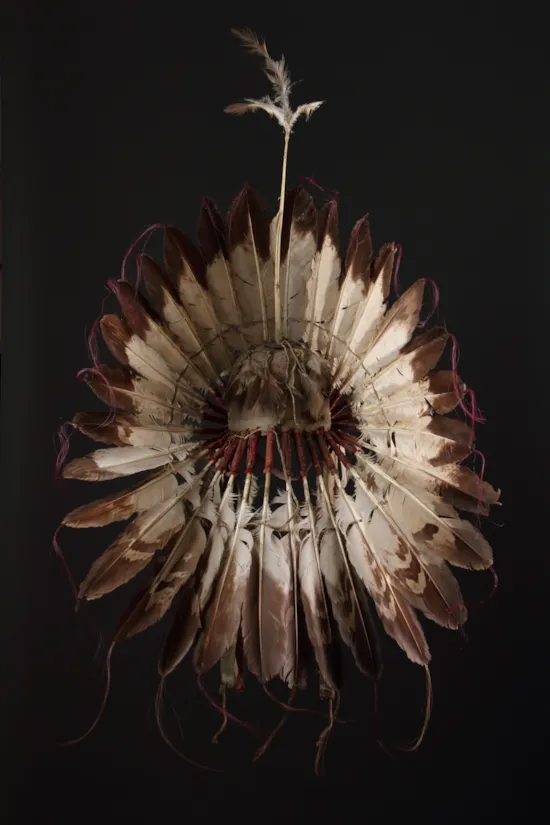A Native American Plains Lakota Sioux Swept Back Eagle Feather War Bonnet
A Native American Plains Lakota Sioux Swept Back Eagle Feather War Bonnet A Skull Cap of Tanned Deer Hide with Sinew Attached Immature Eagle Feathers and Central Flying Plume of Fluff or Breath Feathers a Brow-Band Sewn to the Edge of Cap above the Forehead Trimmed with Glass Seed Beads and with Thirty Golden Eagle Feathers Attached with Strips of Red Trade Cloth all Edged with Red Dyed Horse Hair
Danglers to each side composed of strips of silk muslin cotton and owl feathers
North America
Circa 1870 - 1900
SIZE: approx: 40cm high, 60cm deep, 45cm wide - 15¾ ins high, 23½ ins deep, 17¾ wide
Danglers to each side composed of strips of silk muslin cotton and owl feathers
North America
Circa 1870 - 1900
SIZE: approx: 40cm high, 60cm deep, 45cm wide - 15¾ ins high, 23½ ins deep, 17¾ wide
Nothing is more symbolic of the Plains Indian than the eagle feather headdress worn by chiefs and other high ranking officers in tribal military society. The eagle feathered bonnet signified a warrior’s prowess in battle and is thought to have originated with the Crow or Sioux.
Pictorial evidence indicates that the swept back war bonnet was developed and accepted as a symbol of prestige among the central and Northern Plains tribes by the early 1800’s. A young Pawnee brave Petalesharro was painted by Charles Bird King in 1822 wearing a flaring headdress of eagle feathers trimmed with ermine skins. Edwin Denig, a factor for the American Fur Company in the 1850s, reported that the Assiniboin were willing to pay two horses for two tails of the war eagle, each containing twelve feathers, if the feathers were wrought into a cap.
The feather of an eagle symbolised the highest honour that a warrior could win. An eagle feather war bonnet could only be worn by an individual who had gained the respect of the leading men in the community and who had gained ‘war honours’. The number of feathers indicated the number of captures and scalps taken in battle. The soft downy immature eagle feathers used on the headdress were symbolic of mysterious forces, their continuous fine fluttering movement suggesting communications with the supernatural powers.
Pictorial evidence indicates that the swept back war bonnet was developed and accepted as a symbol of prestige among the central and Northern Plains tribes by the early 1800’s. A young Pawnee brave Petalesharro was painted by Charles Bird King in 1822 wearing a flaring headdress of eagle feathers trimmed with ermine skins. Edwin Denig, a factor for the American Fur Company in the 1850s, reported that the Assiniboin were willing to pay two horses for two tails of the war eagle, each containing twelve feathers, if the feathers were wrought into a cap.
The feather of an eagle symbolised the highest honour that a warrior could win. An eagle feather war bonnet could only be worn by an individual who had gained the respect of the leading men in the community and who had gained ‘war honours’. The number of feathers indicated the number of captures and scalps taken in battle. The soft downy immature eagle feathers used on the headdress were symbolic of mysterious forces, their continuous fine fluttering movement suggesting communications with the supernatural powers.
Ex Private collection Mario Luraschi, Paris
Ex Private European collection
Finch and Co, catalogue no. 24, item no. 1, 2015
Ex Private U.K. collection
Ex Private European collection
Finch and Co, catalogue no. 24, item no. 1, 2015
Ex Private U.K. collection
A Native American Plains Lakota Sioux Swept Back Eagle Feather War Bonnet
















